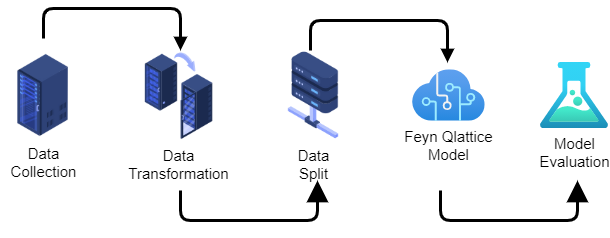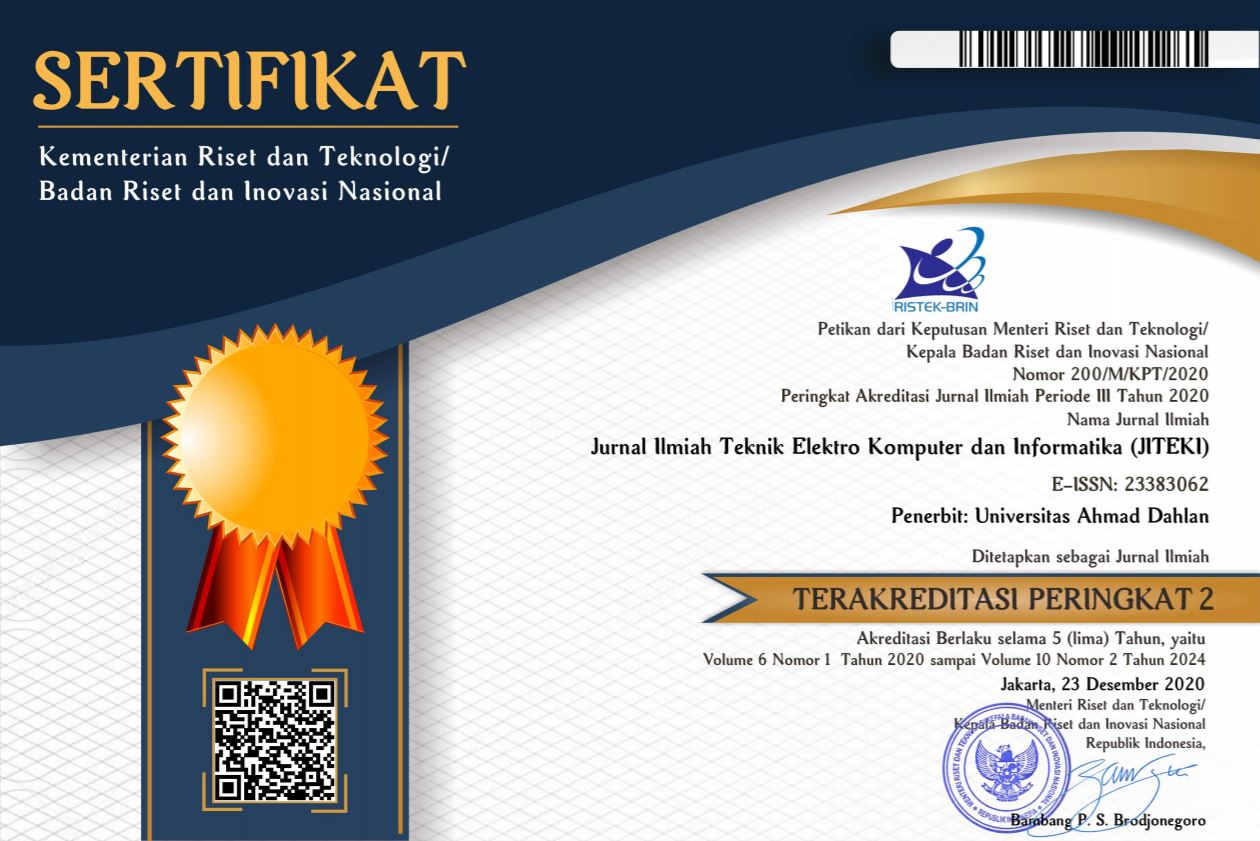
Linkage Detection of Features that Cause Stroke using Feyn Qlattice Machine Learning Model
Abstract
Keywords
Full Text:
PDFReferences
J. Liu, Y. Sun, J. Ma, J. Tu, Y. Deng, P. He, R. Li, F. Hu, H. Huang, X. Zhou, and S. Xu, “Analysis of main risk factors causing stroke in Shanxi Province based on machine learning models,†Informatics Med. Unlocked, vol. 26, p. 100712, 2021. https://doi.org/10.1016/j.imu.2021.100712
W. C. Chen, M. Y. Hsiao, and T. G. Wang, “Prognostic factors of functional outcome in post-acute stroke in the rehabilitation unit,†Journal of Formosan Medical Association, 2021. https://doi.org/10.1016/j.jfma.2021.07.009
J. D. Perkins, S. S. Wilkins, S. Kamran, and A. Shuaib, “Post-traumatic stress disorder and its association with stroke and stroke risk factors: A literature review,†Neurobiol. Stress, vol. 14, no. 100332, pp. 1–14, 2021. https://doi.org/10.1016/j.ynstr.2021.100332
A. Tjan, I. G. R. Widiana, E. D. Martadiani, I. M. D. P. Ayusta, M. W. Asih, and F. P. Sitanggang, “Carotid artery stiffness measured by strain elastography ultrasound is a stroke risk factor,†Clin. Epidemiol. Glob. Heal., vol. 12, no. May, pp. 1–5, 2021. https://doi.org/10.1016/j.cegh.2021.100850
O. Ookeditse, T. R. Motswakadikgwa, K. K. Ookeditse, G. Masilo, Y. Bogatsu, B. C. Lekobe, M. Mosepele, H. Schirmer, and S. H. Johnsen “Healthcare professionals’ knowledge of modifiable stroke risk factors: A cross-sectional questionnaire survey in greater Gaborone, Botswana,†eNeurologicalSci, vol. 25, no. 100365, pp. 1–6, 2021. https://doi.org/10.1016/j.ensci.2021.100365
F. Khennou, Y. I. Khamlichi, and N. E. H. Chaoui, “Improving the use of big data analytics within electronic health records: A case study based OpenEHR,†in Procedia Computer Science, 2018, vol. 127, pp. 60–68. https://doi.org/10.1016/j.procs.2018.01.098
M. Tavana, “Transforming healthcare one byte at a time in the world of big data,†Healthc. Anal., vol. 1, p. 100003, 2021. https://doi.org/10.1016/j.health.2021.100003
Y. Yang, X. Zheng, W. Guo, X. Liu, and V. Chang, “Privacy-preserving fusion of IoT and big data for e-health,†Futur. Gener. Comput. Syst., vol. 86, pp. 1437–1455, 2018. https://doi.org/10.1016/j.future.2018.01.003
Beata Butryn, I. Chomiak-Orsa, K. Hauke, M. Pondel, Agnieszka, and Siennicka, “Application of Machine Learning in medical data analysis illustrated with an example of association rules,†in Procedia Computer Science, 2021, vol. 192, pp. 3134–3143. https://doi.org/10.1016/j.procs.2021.09.086
J. Waring, C. Lindvall, and R. Umeton, “Automated machine learning: Review of the state-of-the-art and opportunities for healthcare,†Artif. Intell. Med., vol. 104, no. October, p. 101822, 2020. https://doi.org/10.1016/j.artmed.2020.101822
K. Kosteva, T. Wu, Y. Wang, K. Chaudhuri, and C. Tanislav, “Predicting the risk of stroke in patients with late-onset epilepsy: A machine learning approach,†Epilepsy Behav., vol. 122, p. 108211, 2021. https://doi.org/10.1016/j.yebeh.2021.108211
L. Velagapudi, N. Mouchtouris, M. P. Baldassari, D. Nauheim, O. Khanna, F. A. Saiegh, N. Herial, M. R. Gooch, S. Tjoumakaris, R. H. Rosenwasser, and P. Jabbour, “Discrepancies in Stroke Distribution and Dataset Origin in Machine Learning for Stroke,†J. Stroke Cerebrovasc. Dis., vol. 30, no. 7, p. 105832, 2021. https://doi.org/10.1016/j.jstrokecerebrovasdis.2021.105832
H. Zhu, L. Jiang, H. Zhang, L. Luo, Y. Chen, and Y. Chen, “An automatic machine learning approach for ischemic stroke onset time identification based on DWI and FLAIR imaging,†NeuroImage Clin., vol. 31, p. 102744, 2021. https://doi.org/10.1016/j.nicl.2021.102744
A. Jamthikar, D. Gupta, N. N. Khanna, L. Saba, J. R. Laird, and J. S. Suri, “Cardiovascular/stroke risk prevention: A new machine learning framework integrating carotid ultrasound image-based phenotypes and its harmonics with conventional risk factors,†Indian Heart J., vol. 72, no. 4, pp. 258–264, 2020. https://doi.org/10.1016/j.ihj.2020.06.004
Abzu, “The QLattice is a radical new machine learning model,†2020. https://www.abzu.ai/qlattice (accessed Oct. 06, 2021).
V. A. Bharadi, “QLattice Environment and Feyn QGraph Models—A New Perspective Toward Deep Learning,†in Emerging Technologies for Healthcare, pp. 69–92 2021. https://doi.org/10.1002/9781119792345.ch3
Fedesoriano, “Stroke Dataset,†2020. https://www.kaggle.com/fedesoriano/stroke-prediction-dataset (accessed Oct. 06, 2021).
G. Y. Wong, F. H.F.Leung, and Sai-HoLing, “A hybrid evolutionary preprocessing method for imbalanced datasets,†Information Sciences, vol. 454–455, pp. 161–177, 2018. https://doi.org/10.1016/j.ins.2018.04.068
K. Stöger, D. Schneeberger, P. Kieseberg, and A. Holzinger, “Legal aspects of data cleansing in medical AI,†Comput. Law Secur. Rev., vol. 42, pp. 1–13, 2021. https://doi.org/10.1016/j.clsr.2021.105587
S. Sachan, F. Almaghrabi, J.-B. Yang, and D.-L. Xu, “Evidential reasoning for preprocessing uncertain categorical data for trustworthy decisions: An application on healthcare and finance,†Expert Syst. Appl., vol. 185, 2021. https://doi.org/10.1016/j.eswa.2021.115597
O. A. Olabanjo, B. S. Aribisala, M. Mazzara, and A. S. Wusu, “An ensemble machine learning model for the prediction of danger zones: Towards a global counter-terrorism,†Soft Comput. Lett., vol. 3, p. 100020, 2021. https://doi.org/10.1016/j.socl.2021.100020
S. Gnat, “Impact of Categorical Variables Encoding on Property Mass Valuation,†in Procedia Computer Science, 2021, vol. 192, pp. 3542–3550. https://doi.org/10.1016/j.procs.2021.09.127
K. Pawluszek-Filipiak and A. Borkowski, “On the importance of train-test split ratio of datasets in automatic landslide detection by supervised classification,†Remote Sens., vol. 12, no. 18, 2020. https://doi.org/10.3390/rs12183054
A. Rácz, D. Bajusz, and K. Héberger, “Effect of dataset size and train/test split ratios in qsar/qspr multiclass classification,†Molecules, vol. 26, no. 4, pp. 1–16, 2021. https://doi.org/10.3390/molecules26041111
G. Sambasivam and G. D. Opiyo, “A predictive machine learning application in agriculture: Cassava disease detection and classification with imbalanced dataset using convolutional neural networks,†Egypt. Informatics J., vol. 22, no. 1, pp. 27–34, 2021. https://doi.org/10.1016/j.eij.2020.02.007
H. Seo, S. Back, S. Lee, D. Park, T. Kim, and K. Lee, “Intra- and inter-epoch temporal context network (IITNet) using sub-epoch features for automatic sleep scoring on raw single-channel EEG,†Biomed. Signal Process. Control, vol. 61, p. 102037, 2020. https://doi.org/10.1016/j.bspc.2020.102037
A. Luque, A. Carrasco, A. MartÃn, and A. de las Heras, “The impact of class imbalance in classification performance metrics based on the binary confusion matrix,†Pattern Recognit., vol. 91, pp. 216–231, 2019. https://doi.org/10.1016/j.patcog.2019.02.023
K. R. Singh, K. P. Neethu, K. Madhurekaa, A. Harita, and P. Mohan, “Parallel SVM model for forest fire prediction,†Soft Comput. Lett., vol. 3, p. 100014, 2021. https://doi.org/10.1016/j.socl.2021.100014
W. Rahmaniar, W.-J. Wang, C.-W. Chiu, and N.L. Hakim “Real-Time Bi-Directional People Counting Using an RGB-D Cameraâ€, Sensors Review, vol. 41, no. 4, pp. 341-349, 2021.
K. Gajowniczek and T. Ząbkowski, “ImbTreeAUC: An R package for building classification trees using the area under the ROC curve (AUC) on imbalanced datasets,†SoftwareX, vol. 15, p. 100755, 2021. https://doi.org/10.1016/j.softx.2021.100755
S. Yang and G. Berdine, “The receiver operating characteristic (ROC) curve,†Southwest Respir. Crit. Care Chronicles, vol. 5, no. 19, p. 34, 2017. https://doi.org/10.12746/swrccc.v5i19.391
T. C. F. Polo and H. A. Miot, “Use of roc curves in clinical and experimental studies,†J. Vasc. Bras., vol. 19, pp. 1–4, 2020. https://doi.org/10.1590/1677-5449.200186
DOI: http://dx.doi.org/10.26555/jiteki.v7i3.22237
Refbacks
- There are currently no refbacks.
Copyright (c) 2021 Purwono Purwono

This work is licensed under a Creative Commons Attribution-ShareAlike 4.0 International License.
| About the Journal | Journal Policies | Author | Information |
Organized by Electrical Engineering Department - Universitas Ahmad Dahlan
Published by Universitas Ahmad Dahlan
Website: http://journal.uad.ac.id/index.php/jiteki
Email 1: jiteki@ee.uad.ac.id



